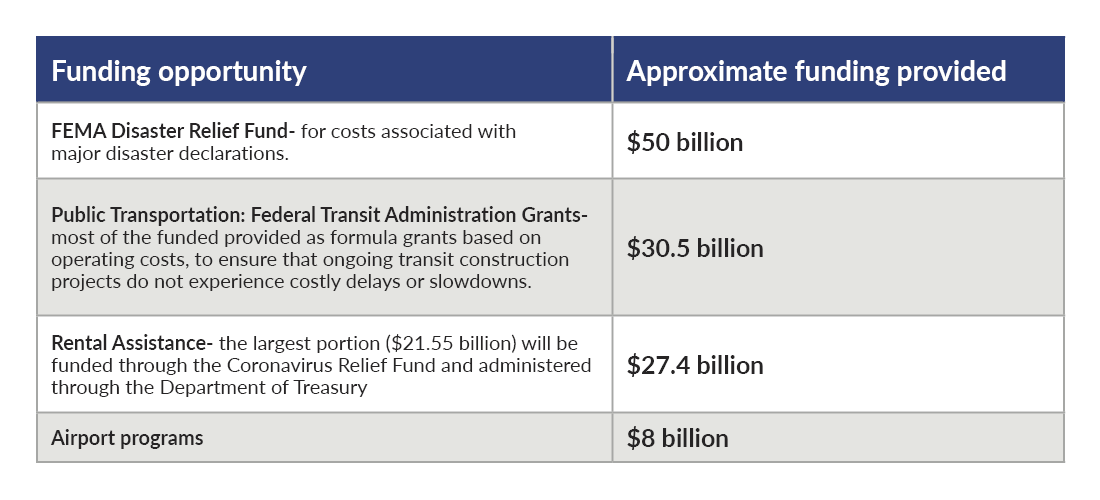How does the American Rescue Plan Act affect the public sector?
This is welcome relief that provides funding through several programs to individuals, businesses, state and local governments, not-for-profits, and educational institutions. Here’s what to know.
 On March 11, 2021, the American Rescue Plan Act (ARPA) was signed into law. The ARPA provides $1.9 trillion of additional relief to respond to the continued impact of COVID-19. This is welcome relief that provides funding through several programs to individuals, businesses, state and local governments, not-for-profits, and educational institutions.
On March 11, 2021, the American Rescue Plan Act (ARPA) was signed into law. The ARPA provides $1.9 trillion of additional relief to respond to the continued impact of COVID-19. This is welcome relief that provides funding through several programs to individuals, businesses, state and local governments, not-for-profits, and educational institutions.Here's how the ARPA relates to certain programs within the public sector.
State and local fiscal aid
The ARPA provides $350 billion to states, territories, and tribal and local governments to use for responding to the COVID-19 public health emergency. This funding stream augments the Coronavirus Relief Fund (CRF) provided through the Department of Treasury under the Coronavirus Aid, Relief, and Economic Security Act (CARES). The major allocations include:
- $195.3 billion to states and the District of Columbia
- $130.2 billion provided to cities and counties
- $10 billion critical infrastructure projects to help states, territories, and tribal governments carry out critical capital projects in response to the pandemic
- $20 billion for tribal governments
- $4.5 billion for territories
- $2 billion county and tribal assistance to make payments to eligible revenue-sharing counties and tribes (those with a negative revenue impact)
State and local relief funds can be used for local economic recovery, including assistance to individuals, small businesses, nonprofits, and for investment in infrastructure. Local governments will begin seeing these dollars very quickly, as the first payment is due 60 days after enactment. Eligible uses now include a provision for lost revenue and must be used by Dec. 31, 2024.
State and local relief funds can be used for local economic recovery, including assistance to individuals, small businesses, nonprofits, and for investment in infrastructure.
K-12 schools
The ARPA provides $122.7 billion in grants to state educational agencies (SEAs) under the Elementary and Secondary School Education Relief Fund (ESSER). No less than 90% must be allocated to local educational agencies (LEAs) to support the implementation of public health protocols to safely reopen schools for in-person learning, address students’ learning loss, and meet students’ long-term academic, social, and emotional needs. The terms and conditions applicable to funds provided in fiscal year 2021 for ESSER apply to these funds too. Below are two stipulations to consider:
- SEAs need to reserve at least 5%, and LEAs must reserve at least 20% of the new ESSER allocation to address learning loss.
- LEAs must create school reopening plans and submit the plans to states.
Additional funding of $800 million is provided for the identification and provision of wraparound services for students experiencing homelessness and approximately $3 billion in funding for programs authorized under the Individuals with Disabilities Education Act. Nonpublic schools that serve a significant percentage of students from low-income families will also see $2.75 billion.
Higher education
Institutions of higher education are provided approximately $40 billion through the Higher Education Emergency Relief Fund (HEERF), which will remain available through Sept. 30, 2023. At least half of this funding must be spent on emergency financial aid grants to students, with the other half available to the institutions to defray lost revenue and increased costs for certain expenses related to declining enrollment, online learning, and COVID-19 testing, among others.
Healthcare
As you’d anticipate, the ARPA provides significant funding (approximately $70 billion) for various public health activities such as distributing and tracking vaccines, contact tracing, mitigation activities, and expanding the U.S. public health workforce. The allocation also includes public health investments such as funding for community health centers and mental health and substance use disorder programs.
The allocation also includes public health investments such as funding for community health centers and mental health and substance use disorder programs.
Other grants and financial assistance
The ARPA provides significant additional funding opportunities, which a few of the more significant include:

This is only a very short summary of the massive relief that’s provided within the ARPA. This bill ensures that the Government Accountability Office and the Pandemic Response Accountability Committee, which was created in the CARES Act, will continue to provide oversight and keep Congress and the public informed about the COVID-19 response and associated spending.
As always, as you navigate through these new funding streams, we’re here to help!




